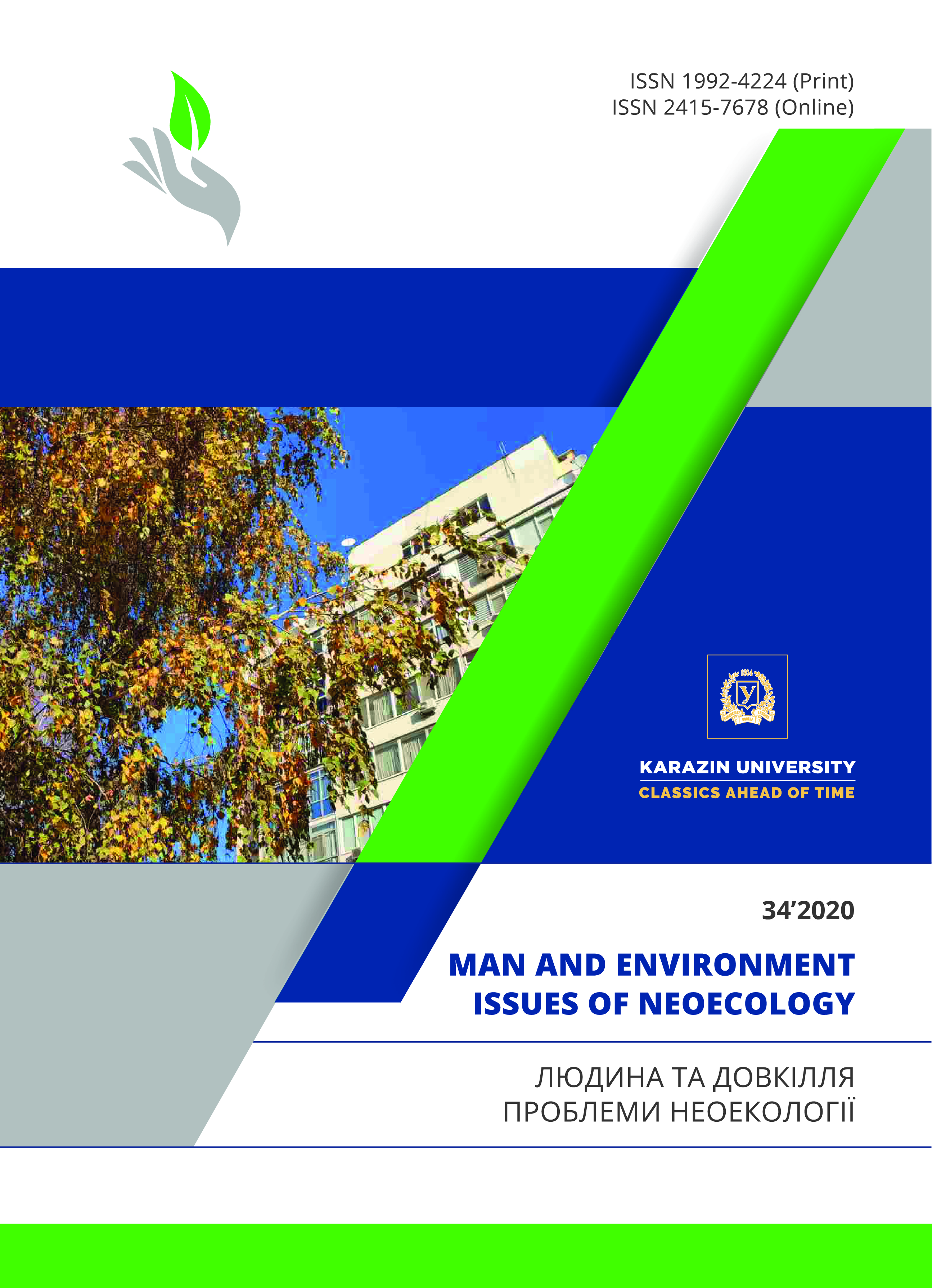Environmental Risk Researches as a Key Element of the Environmental Impact Assessment
Abstract
Purpose. Describe the categories of environmental risk, the degree of their impact on the environment.
Results. The place of ecological risk in the system of environmental impact assessment is substantiated. Modern methodology for environmental risk assessment involves a parallel consideration of risks to human health and environmental risks caused by disturbance of ecosystems and adverse effects on environmental components, risks of deteriorating quality and deteriorating living conditions. The reasons for the risk are unplanned events in the environment that may adversely affect the company, the progress of its plans. These include both predictable and unpredictable events. Risk factors are the conditions under which risk causes may arise. Among them are: political, scientific and technical, socio-economic, environmental and more.
Conclusions. In the strategic perspective, it is necessary to improve the national environmental policy and create a national system of environmental safety and an effective system of environmental monitoring as a universal tool for its implementation. One of the tasks of this system is effective environmental risk management.
Downloads
References
Lysychenko, H. (2011). Methodology for environmental risk assessment. Odesa, Astroprint. (In Ukrainian).
Boyko, T. (2015). Assessment of environmental risks from environmental impacts of man-made objects. Bulletin of Vinnytsia Polytechnic Institute, 4, 31-35. Retrieved from http://nbuv.gov.ua/UJRN/vvpi_2015_4_7 (In Ukrainian).
Vasylyshyn, H. (2013). Scientific and methodological principles of environmental risk assessment in Ukraine in the context of environmental insurance. Scientific Bulletin of NLTU of Ukraine, 23.10, 355-363. Retrieved from http://nbuv.gov.ua/UJRN/nvnltu_2013_23.10_58 (In Ukrainian).
Kozulia, T. (2016). Theoretical and methodological bases of complex analysis and assessment of environmental friendliness of natural and man-made objects. System research & information technologies, 1, 73-84. Retrieved from http://journal.iasa.kpi.ua/article/view/65673 (In Ukrainian).
Zhelobetska, T. (2012). Risk as an assessment of danger due to emergencies. Life Safety, 12, 35-38. Retrieved from http://catalog.library.tnpu.edu.ua:8080/library/DocDescription?doc_id=514739 (In Ukrainian).
Kozulia, T. (2015). Environmental risk at the different levels of research of natural and man-made systems, information support of its assessment. Problems of information technologies, 17, 138-144. Retrieved from http://nbuv.gov.ua/UJRN/Pit_2015_1_24 (In Ukrainian).
Environmental management system: DSTU ISO 14001-97, DSTU ISO 14004–97. (1998). Кyiv: State Standard of Ukraine. Retrieved from http://ea.donntu.edu.ua/bitstream/123456789/27586/25/ %D0%A2%D0%B5%D0%BC%D0%B0%2016.pdf (In Ukrainian).
Sirik, I. (2011). Risk management in the process of making managerial decisions. AgroSvit: Scientific and practical journal, 13/14, 72-76. Retrieved from http://www.agrosvit.info/pdf/13-14_2011/18.pdf (In Ukrainian).
Directive 2004/35/EU of the European Parliament and of the Council of 21 April 2004 «Environmental liability for the prevention and elimination of the effects of damage to the environment». Retrieved 2020, September 05 from https://zakon.rada.gov.ua/laws/show/994_965#Text
Karintseva, O. (2017). Scientific and methodological approach to environmental risk assessment of different types of economic activity. Marketing and innovation management, 3, 378-388. Retrieved from https://mmi.fem.sumdu.edu.ua/journals/2017/3/378-388 (In Ukrainian).
Environmental Impact Assessment (EIA). Retrieved from http://www.unece.org/fileadmin/DAM/env/pp/ compliance/C201387/Communication/Annexes/4._Environmental_Impact_Assessment__EIA_.pdf
Kozulia, T. (2012). Theoretical and practical bases of methodology of complex estimation of ecology of territorial and object systems. Problems of information technologies, 01 (011), 37-45. Retrieved from http://nbuv.gov.ua/UJRN/Pit_2012_1_8 (In Ukrainian).
Liu, S.Y. (2012). Current Progress of Environmental Risk Assessment Research. Procedia Environmental Sciences, 13, 1477-1483. https://doi.org/10.1016/j.proenv.2012.01.139
Hadetska, Z. (2015). Environmental risk assessment on the territory of Ukraine. Efficient economy, 12, 46-54. Retrieved from http://www.economy.nayka.com.ua/?op=1&z=4679 (In Ukrainian).
Statiuha, H. (2010). On the issue of quantitative assessment of environmental safety at the EIA. Eastern European Journal of Advanced Technology, 6/6(48), 44-46. Retrieved from https://cyberleninka.ru/article/n/do-pitannya-kilkisnoyi-otsinki-ekologichnoyi-bezpeki-pri-ovns (In Ukrainian).
Monarch, V. (2017). Concepts and approaches to environmental risk assessment. International scientific journal «Internauka», 4, 50-54. Retrieved from http://nbuv.gov.ua/UJRN/mnj_2017_7_10 (In Ukrainian).
Shaporenko, O. (2014). Economic and environmental risks: definition, assessment, management and principles. Scientific notes of the KROK University, 35, 182-189. http://nbuv.gov.ua/UJRN/Vzuk_2014_35_27 (In Ukrainian).
Fesselmeyer, E. (2013). Strategic exploitation of a common resource under environmental risk. Journal of economic dynamics & control, 37, 125-136. https://dx.doi.org/10.1016/j.jedc.2012.06.010
Integrated Risk Information System. Retrieved 2020, September 9 from https://www2.epa.gov/iris
Kosyakova, A. (2019). The impact of environmental risks on the management of industrial enterprises. The European Proceedings of Social & Behavioural Sciences. Future Academy, 1610-1620. Retrieved from https://www.researchgate.net/publication/331905467_The_Impact_Of_Environmental_Risks_On_The_Management_Of_Industrial_Enterprises
Authors reserve the right of attribution for the submitted manuscript, while transferring to the Journal the right to publish the article under the Creative Commons Attribution License 4.0 International (CC BY 4.0). This license allows free distribution of the published work under the condition of proper attribution of the original authors and the initial publication source (i.e. the Journal)
Authors have the right to enter into separate agreements for additional non-exclusive distribution of the work in the form it was published in the Journal (such as publishing the article on the institutional website or as a part of a monograph), provided the original publication in this Journal is properly referenced
The Journal allows and encourages online publication of the manuscripts (such as on personal web pages), even when such a manuscript is still under editorial consideration, since it allows for a productive scientific discussion and better citation dynamics (see The Effect of Open Access).





